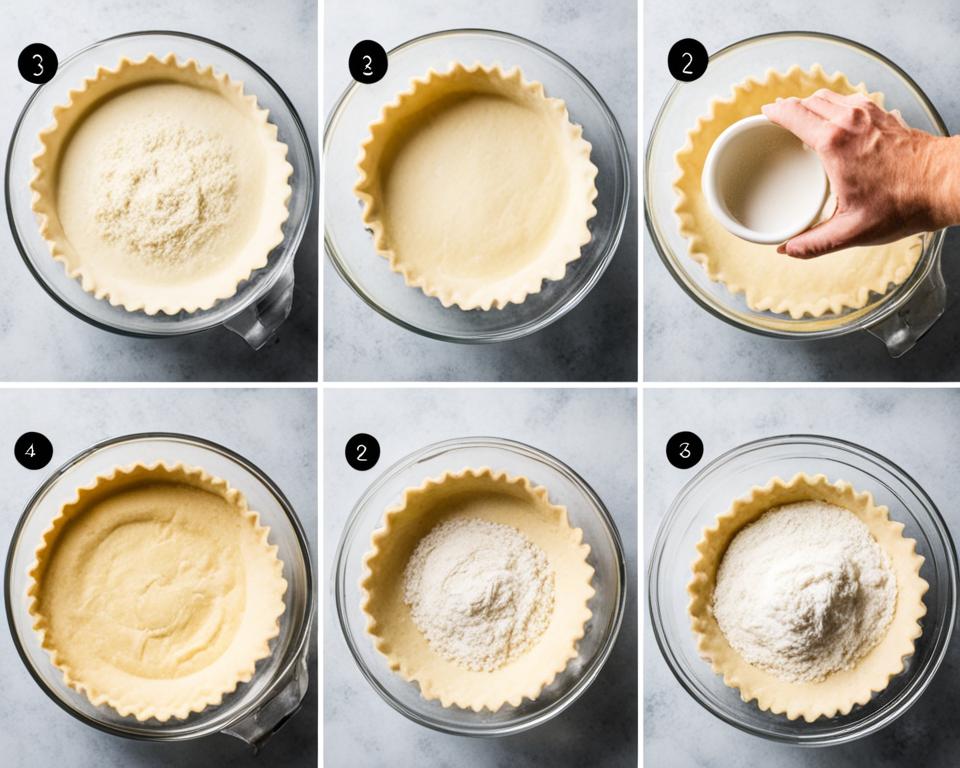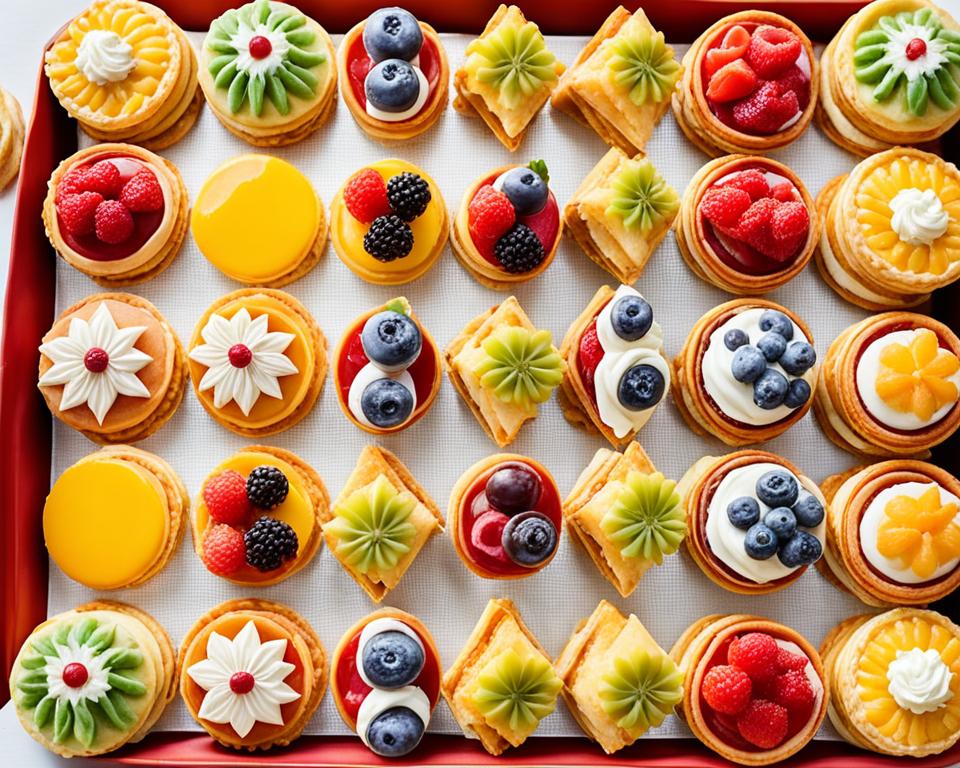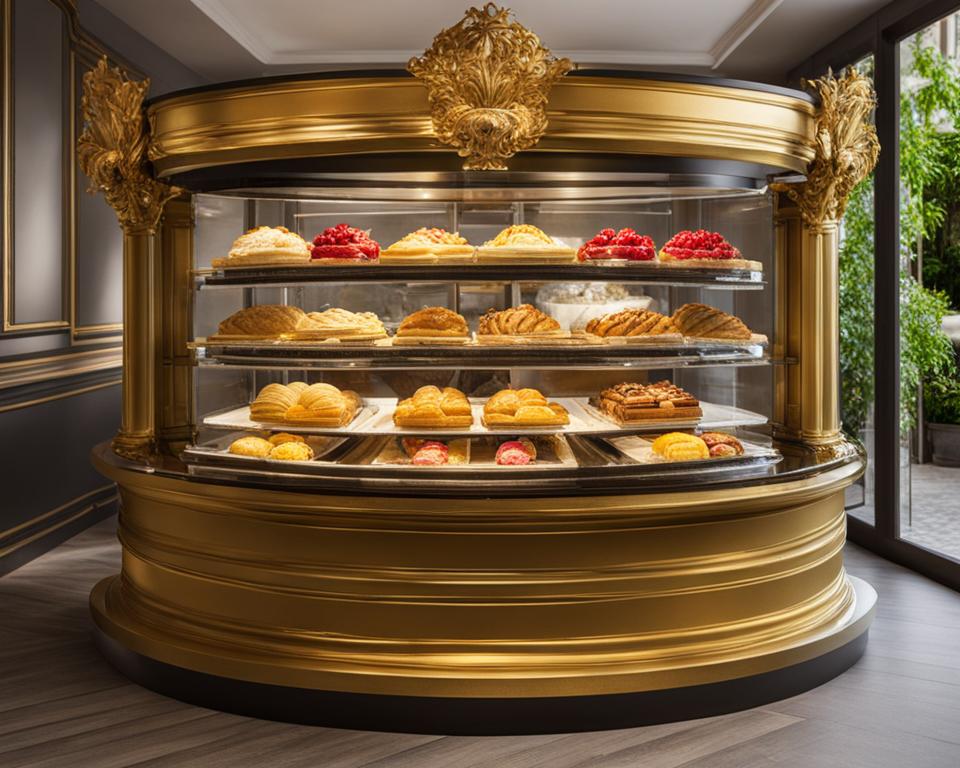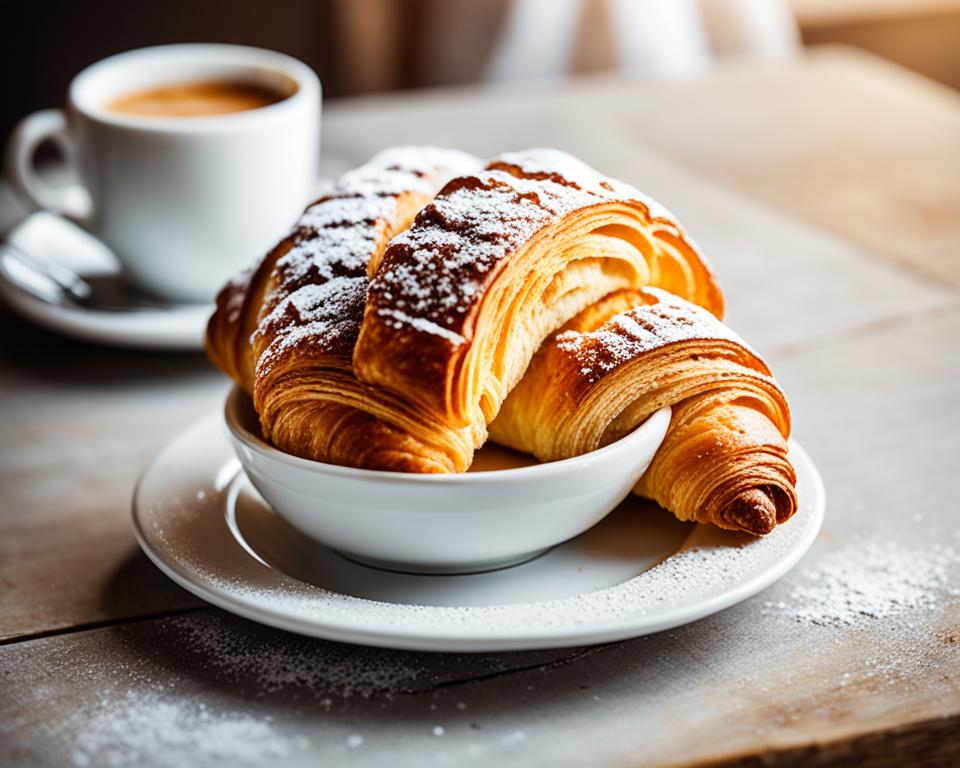Achieving a perfectly flaky crust for your pies can be a challenge, but with the right tips and techniques, it’s totally attainable. By following these easy tips, you’ll be able to create a flaky pie crust every time. From the right flour-fat-water ratio to choosing the right fats and keeping your ingredients cold, these tips will ensure that your homemade crust is flaky and delicious.
Key Takeaways:
- Use the proper flour-fat-water ratio for a flaky crust.
- Choose the right fats, such as butter, lard, or shortening, to achieve flakiness.
- Keep your ingredients cold throughout the process to maintain the flakiness.
- Consider adding vinegar or vodka to the dough for added flakiness.
- Avoid overworking the dough to prevent a tough crust.
Flour-Fat-Water Ratio for Flaky Crust
When it comes to achieving a flaky pie crust, getting the flour-fat-water ratio right is crucial. This ratio determines the texture and consistency of the dough, which in turn affects how flaky the crust will turn out. Most pie dough recipes follow a standard ratio of 3 parts flour, 2 parts fat, and 1 part water.
It’s important to be mindful when adding water to the dough. Start with less water and gradually add more if needed. The goal is to create a dough that is malleable and holds together without being too wet. Adding too much water can result in a tough and less flaky crust.
To properly measure the ingredients, use measuring cups and spoons, ensuring accuracy and consistency. Level off the flour in the measuring cup, and use cold fat such as butter, lard, or shortening. Keeping the fat cold helps maintain its solid state, creating those desirable flaky layers when baked.
Remember, finding the right balance of flour, fat, and water is key to achieving the perfect flaky crust. It may take some practice and experimentation, but once you find the optimal ratio that works for you, you’ll be on your way to creating delicious pies with a flaky and tender crust.
If you’re unsure about the consistency of your dough, remember that you can always adjust by either adding more flour if it’s too wet or a little bit of water if it’s too dry. The dough should come together easily, without being too sticky or crumbling apart.
Expert Tip:
You can also achieve a flakier crust by incorporating a small amount of vinegar or vodka into the dough. Adding either of these liquids helps to relax the gluten, resulting in a tender and flaky crust. Just be sure not to overdo it, as adding too much liquid can make the dough too sticky.
Tools for the Perfect Flaky Crust:
| Tool | Usage |
|---|---|
| Measuring cups and spoons | Accurately measure the ingredients for the perfect ratio |
| Food processor or pastry cutter | Efficiently incorporate cold fats into the dough |
| Rolling pin | Roll out the dough to the desired thickness without stretching it too much |
| Pie weights or dried beans | Prevent the crust from puffing up during pre-baking |
Choosing the Right Fats for Flaky Crust
The type of fats you use in your pie crust can greatly affect its flakiness. Butter, lard, and shortening are commonly used fats in pie dough recipes. Butter provides the most flavor, while lard and shortening contribute to the tenderness of the crust. A combination of butter and lard or shortening can result in a flakier crust with pockets of air when baked. Experiment with different combinations to find the perfect balance for your desired flakiness.
Comparison of Fats for Flaky Pie Crust
| Fat | Flavor | Tenderness |
|---|---|---|
| Butter | Rich and flavorful | Less tender, more layers |
| Lard | Mild flavor | Very tender, less layers |
| Shortening | No flavor | Very tender, less layers |
| Butter + Lard | Rich and flavorful | Moderately tender, more layers |
| Butter + Shortening | Rich and flavorful | Moderately tender, more layers |
As the table shows, different fats offer varying levels of flavor and tenderness in your pie crust. By understanding the characteristics of each fat, you can tailor your recipe to achieve the desired texture and taste. Whether you prefer a buttery flavor, a super tender crust, or a combination of both, choosing the right fats is essential in creating a flaky pie crust.
Keeping Ingredients Cold for Flaky Crust
One of the secrets to achieving a perfectly flaky pie crust is keeping your ingredients cold. Maintaining a low temperature throughout the pie-making process ensures that the fats in the dough remain in solid form, resulting in beautiful pockets of air when baked. Here are some tips for keeping your ingredients cold:
- Chill your fats: Before incorporating butter, lard, or shortening into your dough, make sure to chill them in the refrigerator. Cold fats are easier to cut or blend into the flour, preventing them from melting too quickly.
- Use a food processor or pastry cutter: When incorporating fats into the flour, it’s best to use a food processor or pastry cutter instead of your hands. The warmth of your hands can quickly melt the fats, compromising the flakiness of the crust.
- Refrigerate the dough: Once the dough is mixed and ready, wrap it tightly in plastic wrap and refrigerate it for at least 30 minutes. This step allows the dough to chill, keeping the fats cold and maintaining the flaky texture.
By following these tips, you’ll ensure that your pie crust has the perfect flakiness. Now let’s move on to the next section and explore the role of vinegar or vodka in creating a flaky crust.
Flaky Crust Techniques at a Glance
| Technique | Description |
|---|---|
| Chilling the fats | Keeping fats cold before incorporating them into the dough. |
| Using a food processor or pastry cutter | Using tools instead of hands to prevent fats from melting. |
| Refrigerating the dough | Allowing the dough to chill before rolling it out. |
The Role of Vinegar or Vodka in Flaky Crust
Adding vinegar or vodka to your pie dough might sound unusual, but it can significantly improve the flakiness of the crust. Both vinegar and vodka add moisture to the dough without encouraging gluten development. This results in a tender and flaky crust. Use either vinegar or vodka interchangeably in your dough, and don’t worry, you won’t taste it in the final product.
By incorporating vinegar or vodka into your pie dough, you can unlock the secrets to achieving a flaky pie crust. These ingredients enhance the texture of the crust by preventing gluten formation, which can make the crust tough and dense. Instead, vinegar or vodka introduces moisture that helps create a delicate, tender, and flaky structure.
When using vinegar, opt for white vinegar or apple cider vinegar. The acidity in vinegar helps to inhibit gluten development, resulting in a lighter and more delicate crust. Alternatively, vodka can also be used. The alcohol in vodka prevents gluten from forming, while evaporating during baking, leaving behind a crisp and flaky crust. You can choose whichever option suits your preference or the ingredients you have on hand.
Combine the vinegar or vodka with the other ingredients in your pie dough recipe, and mix until just combined. Be careful not to overwork the dough, as this can lead to a tougher crust. Once the dough comes together, wrap it in plastic wrap and refrigerate for at least 30 minutes to allow the gluten to relax and the fats to solidify.
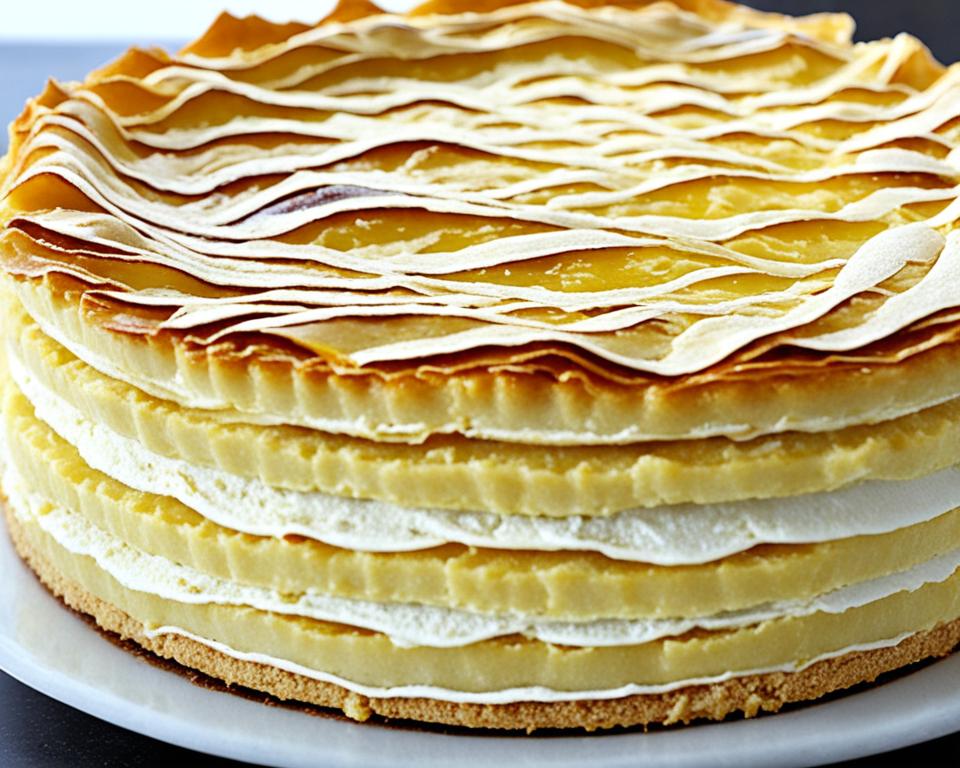
Why Vinegar or Vodka?
Vinegar and vodka are effective ingredients for achieving flaky pie crust due to their unique properties:
Vinegar: The acidity in vinegar helps to inhibit gluten development, resulting in a lighter and more delicate crust.
Vodka: The alcohol in vodka prevents gluten from forming, while evaporating during baking, leaving behind a crisp and flaky crust.
These ingredients work wonders when incorporated into your pie dough, helping you create a perfect flaky crust. So if you’re aiming for the best results, don’t hesitate to give vinegar or vodka a try.
| Vinegar | Vodka |
|---|---|
| Acidic | Alcoholic |
| Inhibits gluten development | Prevents gluten formation |
| Lighter and delicate crust | Crisp and flaky crust |
Avoid Overworking the Dough for Flaky Crust
One of the secrets to achieving a perfect flaky crust is to avoid overworking the dough. When you overwork the dough, you risk ending up with a tough crust that lacks the desired flakiness. So, how can you prevent this from happening?
First, it’s important to work the dough just enough for it to come together and be malleable in your hands. Remember, the goal is to mix the ingredients evenly without developing too much gluten. The more you work the dough, the more gluten develops, resulting in a tougher texture.
Be gentle when mixing and handling the dough. Avoid excessive kneading or rolling, as this can lead to the fat in the dough melting, resulting in a loss of those precious flaky layers. Instead, aim to work quickly and efficiently to keep the dough cold and intact.
“Overworking the dough can lead to a tough crust lacking in flakiness.”
| DO: | AVOID: |
|---|---|
| – Mix the dough just until it comes together | – Kneading the dough excessively |
| – Handle the dough gently | – Rolling the dough too many times |
| – Work quickly to keep the dough cold | – Letting the dough rest for too long |
Remember:
- Less is more when it comes to working the dough.
- Keep the fat in the dough cold for flakier results.
- Work efficiently and avoid overhandling to maintain the desired texture.
By following these tips, you’ll be able to achieve a flaky pie crust that will impress your family and friends. Remember, the secret lies in gentle handling and working quickly to preserve the delicate layers within the dough.
The Importance of Egg Wash for Flaky Crust
When it comes to creating a perfect flaky pie crust, every step plays a crucial role. One often overlooked yet essential technique is applying an egg wash to the bottom of your crust before adding the filling. This simple step can make a significant difference in the outcome of your pie.
An egg wash creates a thin, protective barrier between the crust and the filling, preventing the juices from seeping into the crust and making it soggy. The result? A beautifully flaky crust that perfectly complements your delicious pie filling.
To apply the egg wash, simply whisk together one egg with a tablespoon of water. Then, use a pastry brush to lightly coat the bottom of the crust with the mixture. Be sure to cover the entire surface to ensure even protection.
But the benefits of the egg wash don’t stop there. Refrigerating the crust with the egg wash helps it chill and maintain its shape while baking. This step is especially crucial for recipes that require blind baking or longer cooking times.
So, before you start pouring your delicious filling into the crust, don’t forget to give it a protective coat of egg wash. Your pie will thank you with a perfect, flaky crust every time.
Adding Flavor to Flaky Crust
While most pie dough recipes stick to the basic ingredients of flour, fat, and water, you can add flavor to your crust to take it to the next level. A simple tablespoon of sugar can provide a touch of sweetness, adding depth of flavor to your pies. But don’t stop there – get creative and experiment with savory flavors as well. Adding herbs and spices, such as thyme, rosemary, or cinnamon, can infuse your crust with delicious aromas and enhance the overall taste of your pie.
If you’re making a savory pie like a quiche or a meat pie, consider adding garlic powder to the crust for an extra kick of flavor. The combination of a flaky crust and savory filling will surely be a crowd-pleaser. Don’t be afraid to step outside the box and try new flavor combinations that complement your pie’s filling.
Remember, the crust is not just a vessel for the filling; it plays an integral role in the overall taste and enjoyment of your pie. So, don’t be afraid to get creative and add your own unique twist to the classic flaky crust recipe.
Tips for Adding Flavor:
- Try adding a tablespoon of sugar to the dough for a touch of sweetness.
- Experiment with savory flavors by adding herbs and spices like thyme, rosemary, or garlic powder.
- For a unique twist, consider incorporating cinnamon or nutmeg for a warm and cozy flavor.
By adding flavor to your flaky crust, you can elevate the taste of your pies and create a memorable culinary experience for yourself and your loved ones.
Remember, the possibilities are endless when it comes to adding flavor to your flaky crust. Don’t be afraid to try new combinations and have fun in the kitchen. Your taste buds will thank you!
Conclusion
Mastering the art of creating a perfect, flaky pie crust is within your reach. By keeping a few key techniques in mind, you can ensure that your pies always have a delightful, flaky crust that will impress everyone at your table. Remember to prioritize the temperature of your ingredients – keep them cold for a better texture. Additionally, try experimenting with different fats, like butter, lard, or shortening, to achieve the desired level of flakiness in your crust.
Avoid overworking the dough, as this can result in a tough crust. Handle the dough gently and only enough to bring it together. By following these essential tips and techniques, you’ll be well on your way to baking pies with the perfect, flaky crust that everyone will love.
So, the next time you’re planning to bake a pie, take some time to apply these flaky crust techniques, and watch as your crust becomes the star of the show. Achieving a perfect flaky crust is definitely attainable. With a little practice and these helpful tips, you’ll be creating mouthwatering pies with a beautifully flaky and tender crust every time.
FAQ
What is the flour-fat-water ratio for achieving a flaky crust?
Most pie dough recipes use a ratio of 3 parts flour, 2 parts fat, and 1 part water. Start with less water and gradually add more as needed until the dough is malleable but not wet.
What are the best fats to use for a flaky crust?
Butter, lard, and shortening are commonly used fats in pie dough recipes. Butter adds flavor, while lard and shortening contribute to the tenderness of the crust. Experiment with different combinations to find the perfect balance for your desired flakiness.
Why is it important to keep the ingredients cold for a flaky crust?
Keeping the ingredients cold ensures that the fat in the dough remains in solid form, creating pockets of air when baked. Chill the fats before incorporating them into the dough and refrigerate the dough before rolling it out to maintain the cold temperature.
How does vinegar or vodka contribute to a flaky crust?
Adding vinegar or vodka to the dough adds moisture without encouraging gluten development, resulting in a tender and flaky crust. Use either interchangeably in your dough for the best results.
Why should you avoid overworking the dough for a flaky crust?
Overworking the dough develops gluten, resulting in a tougher crust and less flakiness. Work the dough just enough for it to come together and be malleable.
What is the importance of an egg wash for a flaky crust?
Applying an egg wash to the bottom of the pie crust before adding the filling creates a barrier that prevents the crust from becoming soggy. Additionally, refrigerating the crust with the egg wash helps it to maintain its shape while baking.
Can you add flavor to a flaky crust?
Yes, you can add flavor to your crust by adding a tablespoon of sugar for a touch of sweetness or experimenting with herbs and spices for savory pies.
How can I achieve a perfect flaky crust every time?
By following these tips, including the flour-fat-water ratio, choosing the right fats, keeping ingredients cold, avoiding overworking the dough, using an egg wash, and adding flavor, you can achieve a perfect flaky crust every time.

